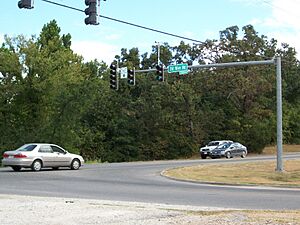Old Wire Road facts for kids
The Old Wire Road is a very old and important road in Missouri and Arkansas. Even today, many local roads still use this name. This road started as an ancient path used by Native Americans, known as the Great Osage Trail. Later, it became a path for a special communication line called a telegraph line. This line stretched all the way from St. Louis, Missouri, to Fort Smith, Arkansas.
The Old Wire Road was also used by the Butterfield Overland Mail, which was a famous stagecoach service. When the telegraph line was active, people called it the "Wire Road." But after the telegraph line was taken down, it became known as the "Old Wire Road." In St. Louis, where the road begins near Jefferson Barracks, it is still called Telegraph Road. Parts of the road from St. Louis to Springfield, Missouri, later became famous routes like U.S. Route 66 and even Interstate 44.
Contents
What is the Old Wire Road?
The Old Wire Road is more than just a path; it's a piece of American history. It shows how people traveled and communicated long ago.
From Native American Trail to Telegraph Line
The road's story began with the Osage people, a Native American tribe. They used this route for travel and trade across the Ozarks. It was a vital path for them.
Much later, in the 1800s, a new invention changed how people sent messages: the telegraph. A telegraph uses electric signals to send messages over long wires. These wires were strung along the old trail, turning it into the "Wire Road." This made it much faster to send news and messages across the country.
The Butterfield Overland Mail
The Old Wire Road was also a key part of the Butterfield Overland Mail route. This was a stagecoach service that delivered mail and passengers across the country. It ran from 1858 to 1861. Imagine traveling by stagecoach for days, carrying important letters and people! The Old Wire Road helped connect many towns and cities along this long journey.
Where Did the Road Go?
The Old Wire Road covered a lot of ground. It started in St. Louis, Missouri, and went southwest.
- It passed through what is now the Wilson's Creek National Battlefield near Springfield, Missouri. This area was important during the Civil War.
- From there, it continued through Christian and Stone counties in Missouri.
- It then crossed into Arkansas.
- In Arkansas, it went near Pea Ridge, Arkansas, and through Fayetteville, Arkansas.
- Finally, it reached its end in Fort Smith, Arkansas.
This long route connected many important places and helped people move and communicate across the region.
The Road's Role in History
The Old Wire Road played a part in some very important events in American history.
The Trail of Tears
Sadly, the Old Wire Road was used during the Trail of Tears. This was a terrible time when many Native American tribes, including the Cherokee, Choctaw, Chickasaw, Creek, and Seminole, were forced to leave their homes in the southeastern United States. They were made to walk long distances to new lands in what is now Oklahoma. The Old Wire Road was one of the paths they were forced to take, and many suffered greatly along the way.
The American Civil War
During the Civil War (1861-1865), the Old Wire Road became very important for both sides. The telegraph line along the road was crucial for sending messages and orders to soldiers. Because it was so important, Confederate soldiers often tried to cut the telegraph wires to stop the Union army from communicating. This shows how vital the road and its telegraph line were during the war.
Today, parts of the Old Wire Road are still used as local roads, reminding us of its long and interesting history.


